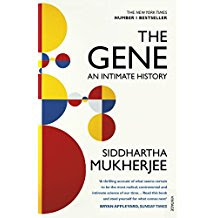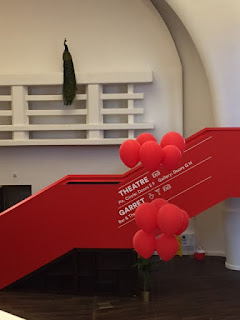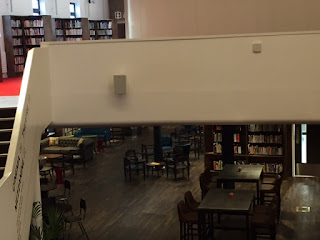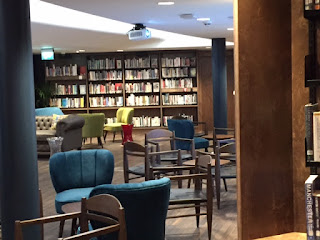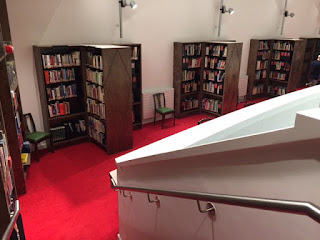I like apples. This week we went to Erddig Hall near Wrexham for their apple show. There are various activities at the weekend during the month of October including cider-making, history of apples, various craft events and family creative writing, but since we went during the week it was relatively quiet.
 |
| East front of Erddig Hall |
The gardens are a big draw at Erddig, with stately avenues of yews
 |
| Garden of Erddig Hall |
fruit trees grown against warm crumbling walls.
 |
| Fruit wall at Erddig |
A specialty is the number of apple varieties produced each year. Some are available to buy (and sample at the weekend).
 |
| Erddig Apple Display |
Dropping our hoard in the car, we went on one of the marked walks in the ground to see the remains of the first Earl of Chester's Motte and Bailey
 |
| Hughes d'Averanches earthworks (eleventh century) |
the Motte now marked out with an avenue of trees leading to views over the surrounding countryside and revealing the reason why
Hugh d'Avranches chose such a spot
 |
| Avenue of trees on motte |
before going on to 'the cup and saucer' a hydraulic ram, invented by one of the Montgolfier brothers, which was used here to pump water up to fountains in the grounds of the house. The National Trust is hoping to bring this pump back to life one day. Meanwhile, the cup and saucer remains an elegant and interesting way to transfer water from one level to another.
 |
| 'Cup and Saucer ' Hydraulic Ram, Erddig |
We finished with a tour around the house, with displays in the servants' quarters
 |
| Butler's Pantry, Erddig |
and stable blocks
 |
| Working Shire Horse at Erddig |
just as interesting as those in the main house.
 |
| Bedroom at Erddig |
The house had been owned by the Yorke family for several hundred years. The family ended in the 1970s with two bachelor brothers, neither of which produced heirs.
 |
| Nursery at Erddig - frozen in time around 1912 |
Philip Yorke, the last brother, who lived at Erddig with a friend, sounds an interesting character. He was a teetotal vegetarian who would not allow motor vehicles onto the estate and relied on sheep to cut the grass and rode around the estate on a penny farthing (which Prince Charles once tried). The house was without electricity, except for a generator which he used to power two televisions tuned to two different channels, and Philip Yorke was determined to leave it all to the National Trust.
 |
| Gas lamp at Erddig. |
At first, the National Trust offered to buy just the furniture (there are 30,000 artifacts here, only 20,000 of which are on display),
 |
| Library at Erddig |
but Philip insisted that they buy the house too. It was a battle because the Trust was reluctant to buy a building that was obviously going to require some extensive renovation. It had been undermined by the National Coalboard, which had resulted in some structural damage. Eventually, Philip won through, the National Trust only persuaded to take the plunge after they had been given permission to sell off some of the estate's land for housing to finance the repairs. Gratifyingly, he live long enough to see the completed project.
 |
| Dressed stone west front of Erddig Hall |
By the time we'd finished with our tour of the building (at the splendid west side, an aspect I'd never encountered before) a few other apples were available to buy - so we added to hoard.
 |
| Apple hoard |
On the subject of apples, I see that Ian Patterson has made this fruit the subject of one of his literary quizzes in his
'Nemo's Almanac' which arrived at my house today, courtesy of Profile Books.
 |
| Nemo's Almanac |
It's based on an appealing idea: quizzes for people who have an interest in books. I can imagine this working really well in literary festivals with an entertaining adjudicator. I've also found it fun to try and guess, and even when I haven't got a clue, I find I learn a lot. For instance, I remember loving the title of a book by Ray Bradbury in my youth, 'The Golden Apples of the Sun', so much I devoted an art project to it, and this afternoon I found the origin on this phrase - suitably enough in 'October' - and discover it is from 'The Song of the Wandering Aengus' by W.B. Yeats:
'I will find out where she has gone,
And kiss her lips and take her hands;
And walk among long dappled grass,
And pluck till time and times are done
The silver apples of the moon,
The golden apples of the sun.'
So now, of course, I want to read the whole poem. Wonderful stuff.






























